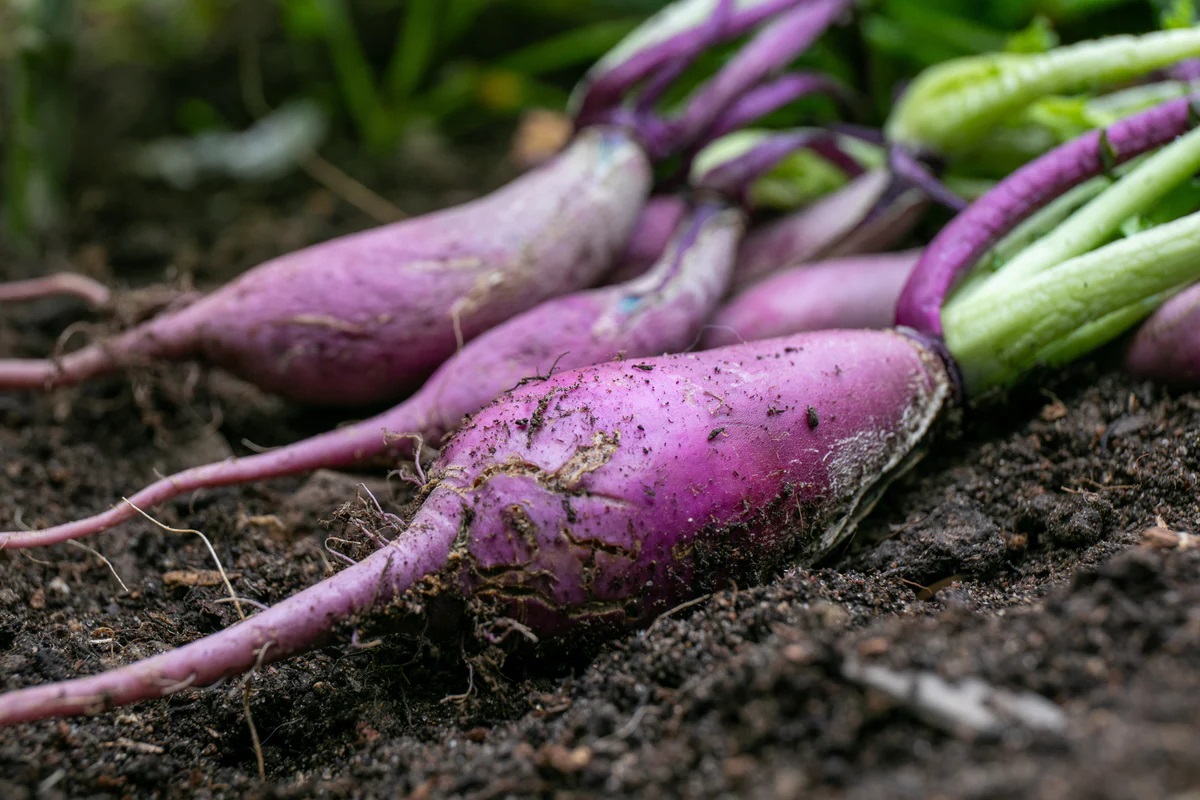
Why are purple radishes so special? These vibrant veggies aren't just eye-catching; they pack a punch of flavor and nutrition. Purple radishes contain anthocyanins, which give them their striking color and act as powerful antioxidants. They also offer a crisp texture and a slightly spicy taste, making them a versatile addition to many dishes. Whether you're tossing them in a salad, pickling them, or using them as a garnish, purple radishes can elevate your meal. Plus, they're low in calories but high in vitamins C and K, fiber, and potassium. Ready to learn more? Let's dig into 20 fascinating facts about these colorful root veggies!
Key Takeaways:
- Purple radishes are nutrient-packed, low-calorie, and high-fiber vegetables with antioxidant properties. They grow quickly, thrive in cool weather, and are versatile in culinary uses, offering health benefits like digestive support and hydration.
- With a vibrant hue and rich history, purple radishes are not only delicious but also symbolize prosperity in some cultures. Their edible leaves and quick growth make them a fun and nutritious addition to any garden or meal.
What is a Purple Radish?
Purple radishes are a colorful variety of the common radish. Known for their vibrant hue and crisp texture, they add a pop of color to salads and dishes. Let's dive into some fascinating facts about this unique vegetable.
-
Rich in Nutrients: Purple radishes are packed with vitamins and minerals, including vitamin C, potassium, and folate. These nutrients help boost the immune system and maintain overall health.
-
Low in Calories: With only about 16 calories per 100 grams, purple radishes are an excellent choice for those looking to maintain a healthy weight.
-
High in Fiber: They contain a good amount of dietary fiber, which aids in digestion and helps keep you feeling full longer.
-
Antioxidant Properties: The vibrant purple color comes from anthocyanins, powerful antioxidants that help protect the body from free radicals.
Growing Purple Radishes
Growing purple radishes can be a rewarding experience. They are relatively easy to cultivate and can thrive in various climates.
-
Quick Growth: Purple radishes mature quickly, often ready for harvest in just 25-30 days after planting.
-
Cool-Weather Crop: They grow best in cooler temperatures, making them ideal for spring and fall planting.
-
Soil Preferences: These radishes prefer well-drained, fertile soil with a pH between 6.0 and 7.0.
-
Spacing: When planting, space seeds about 1 inch apart to ensure they have enough room to grow.
Culinary Uses of Purple Radishes
Purple radishes are not only nutritious but also versatile in the kitchen. They can be used in various dishes to add flavor and color.
-
Salads: Sliced or shredded purple radishes add a crunchy texture and a burst of color to salads.
-
Pickling: They can be pickled to create a tangy, crunchy snack that pairs well with sandwiches and charcuterie boards.
-
Roasting: Roasting purple radishes brings out their natural sweetness and makes for a delicious side dish.
-
Garnishes: Use thin slices as a vibrant garnish for soups, tacos, and other dishes.
Health Benefits of Purple Radishes
Including purple radishes in your diet can offer several health benefits. Their nutrient-rich profile supports various aspects of well-being.
-
Digestive Health: The fiber content in purple radishes promotes healthy digestion and prevents constipation.
-
Hydration: With a high water content, they help keep you hydrated, especially during hot weather.
-
Detoxification: Purple radishes support liver function and help detoxify the body by flushing out toxins.
-
Heart Health: The potassium in purple radishes helps regulate blood pressure and supports cardiovascular health.
Fun Facts About Purple Radishes
Purple radishes have some interesting characteristics and history that make them even more intriguing.
-
Ancient Roots: Radishes have been cultivated for thousands of years, with evidence of their use in ancient Egypt and Greece.
-
Variety of Colors: Besides purple, radishes come in various colors, including red, white, and black.
-
Symbolism: In some cultures, radishes symbolize prosperity and good fortune.
-
Edible Leaves: The leaves of purple radishes are also edible and can be used in salads, soups, and stir-fries.
The Final Bite on Purple Radishes
Purple radishes aren't just pretty; they're packed with benefits. From boosting your immune system to aiding digestion, these vibrant veggies deserve a spot on your plate. Their unique color comes from anthocyanins, which have antioxidant properties. Plus, they're low in calories but high in fiber, making them a great choice for weight management.
Growing them is a breeze too. They thrive in cool weather and can be harvested in just a few weeks. Whether you enjoy them raw, pickled, or cooked, purple radishes add a pop of color and a peppery crunch to any dish.
So next time you're at the market, grab a bunch of these purple gems. Your taste buds and your body will thank you. Happy munching!
Frequently Asked Questions
Was this page helpful?
Our commitment to delivering trustworthy and engaging content is at the heart of what we do. Each fact on our site is contributed by real users like you, bringing a wealth of diverse insights and information. To ensure the highest standards of accuracy and reliability, our dedicated editors meticulously review each submission. This process guarantees that the facts we share are not only fascinating but also credible. Trust in our commitment to quality and authenticity as you explore and learn with us.


